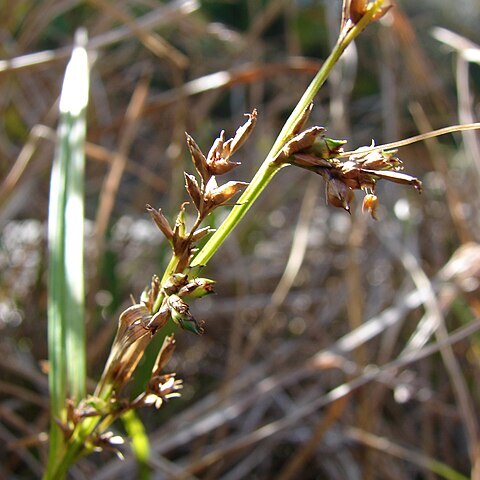Herbs usually perennial, sometimes annual, cespitose or not, rhizomatous or not. Culms solitary or not, unbranched proximal to inflorescence, trigonous, (6–)10–100(–125) cm (high-climbing into trees), weak or wiry. Leaves few to many per culm, cauline, 3-ranked; sheaths present; ligules usually well developed, sometimes obsolete; blades well developed (or rudimentary, sometimes absent on proximal leaves), shorter than, equaling, or overtopping culms, plane, keeled, or revolute, 0.5–9 mm wide, stiff, with prominent midvein, glabrous, scabrous, or pubescent. Inflorescences terminal, often axillary, sometimes pseudolateral, panicles, spikes, or 1 or more capitate or fasciculate clusters; spikelets 1–100+; bracts 1–3, ascending or erect, bristle-shaped, awl-shaped, or leaflike, sometimes appearing to be continuation of culm, 10–150 mm, shorter than or exceeding spikelets, glabrous or ciliate. Spikelets: scales 3–10+, each subtending flower, distichous, proximal 2–4 scales empty, proximal fertile scale pistillate, distal fertile scales staminate or sometimes empty; occasionally some spikelets entirely pistillate or staminate. Flowers unisexual; perianth absent; stamens 1–3; anthers 2–4 mm, apex usually mucronate or awned; styles linear, 2–3-fid, base deciduous or persistent, hypogynium rudimentary or prominent, slender or enlarged. Achenes trigonous or rounded, 1–4 mm, smooth, tuberculate, verrucose, or reticulate, occasionally pubescent.
Herbs, perennial or annual, rhizomatous or not; stolons sometimes present. Culms erect, 3-angled or rarely terete. Leaves cauline or both basal and cauline; sheaths at middle part of culm, winged or not, apex sometimes with contraligule opposite blade; leaf blade linear, scabrid, sheathing, usually prominently 3-veined. Involucral bracts leaflike and sheathing, setaceous, or glumelike; bractlets usually setaceous, rarely glumelike. Inflorescences terminal, paniculate, usually stout and elongated, sometimes reduced into a discontinuous spike. Unisexual spikelets usually dominant on inflorescence, rarely bisexual ones dominant; basal 2-4 glumes of spikelets empty. Male spikelets with several flowers. Female spikelets with a single flower. Bisexual spikelets with a basal female flower and several male flowers. Flowers unisexual. Male flowers: stamens 1-3; anthers linear or linear-oblong; connective apex often protruding and subulate. Female flowers: style base not inflated; stigmas 3. Nutlet brick red, white, or yellowish purple, spherical or ovoid, often obtusely 3-sided, smooth or variously sculptured, mostly shiny, glabrous or hairy (hairs simple or stellate), usually borne on a gynophore apically dilated into a ± 3-lobed disk.
Fls unisexual, the plant monoecious; spikelets small, the staminate few-fld, the pistillate with the lower scales empty and only the uppermost one fertile; perianth none; stamens 1–3; style trifid; achene bony or crustaceous, usually white or whitish, globose to ovoid or obscurely trigonous, obtuse or apiculate, in our spp. subtended by a simple or variously ornamented disk (hypogynium); sedges with trigonous culms and solitary or few, small, compact cymes. 200, warm reg.
Mostly leafy perennials, with small monoecious spikelets in terminal or axillary fascicles, or in interrupted spikes; fertile spikelets 1-flowered with several empty scales; staminate. spikelets many-flowered; achene crustaceous, globose to ovoid, frequently supported on a lobed or laciniate disc (hypogynium); stamens 1-3; style 3-cleft. About 100 species, chiefly in tropics of both hemispheres.

